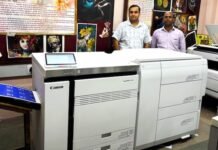Epson has built a new factory to increase the production capacity of its MicroTFP (Thin Film Piezo) inkjet printheads. The new factory, which cost ¥3.5 billion, roughly £19.4 million, sits alongside Epson’s existing Akita facility in Japan.
Epson already manufactures printheads at the Akita plant and the new building will more or less triple Akita Epson’s current printhead production capacity. Construction began on the new factory in November 2022 and was completed on schedule in December 2023. The Akita plant was set up in June 1986 and has been frequently expanded with, for example, a new building added in 2020 for the production of watches.
The new factory will be used to manufacture and assemble inkjet printheads for high-capacity ink tank printers and business inkjet printers, which mostly seems to mean printers designed for office and workgroup use rather than professional graphics. Epson’s press release noted that the office and home inkjet printer markets have seen strong demand for decentralized printing since the pandemic along with growth in high-capacity ink tank printers in emerging markets as well as North America and other developed economies.
Interestingly, Epson says that only around 20% of its current inkjet printer range is using its PrecisionCore printheads with the rest using older variants of its MicroTFP heads.
However, there is enough space at the Akita facility for further expansion, which could include sales of printheads to other OEM vendors as well as assembling more PrecisionCore printheads. The press release went on to point out that there was increased demand in the commercial and industrial printing segments, particularly for digital printing to textiles.
The key to this story lies in an earlier announcement dating back to 2018 regarding a new factory at Epson’s Hirooka office in Shiojiri, Japan. Epson uses this factory, which cost ¥25.5 billion or £137.4 million, to produce PrecisionCore print chips. These chips are the underlying basis of the PrecisionCore printheads, with multiple chips combined together to make each head. This was Epson’s second PrecisionCore chips manufacturing plant, after the Suwa Minami Plant in Nagano Prefecture, Japan. Increasing the production of the print chips is a precursor to manufacturing printheads at plants such as the new Akita facility.
It’s worth noting that Epson has been steadily increasing its inkjet facilities across the board, including for research, for increased OEM sales, and for manufacturing. In 2020 Epson opened a new Innovation Centre Building B, also at the Hirooka office, for building prototypes and mass manufacturing of large commercial and industrial printing systems as well as housing a test laboratory for digital textile printing.
In 2022 Epson revamped its Inkjet Innovation Lab Fujimi to promote commercial and industrial inkjet innovation. Epson installed a new color inkjet three-dimensional printing device and improved the ability to experiment with new applications involving inkjet printheads, such as electronics and biotechnology.
Epson has previously said that expanding its commercial and industrial printing sales is a key part of its Epson 25 corporate vision.
You can find further details on Epson’s inkjet products from epson.co.uk.
First published in the Printing and Manufacturing Journal on 16th January 2024. Reprinted with permission www.nessancleary.co.uk

















